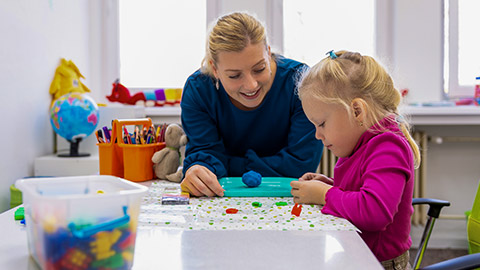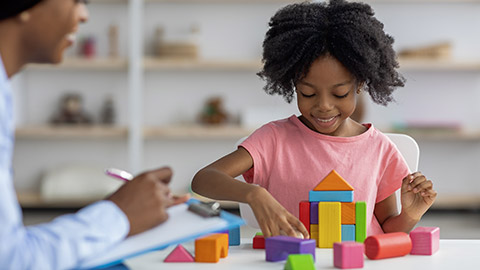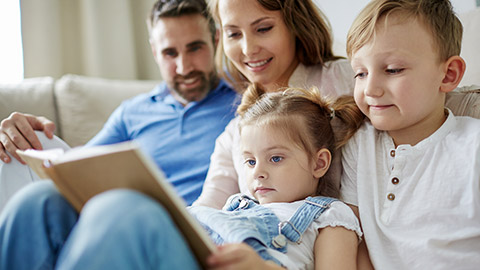Warm, sensitive and responsive communication with children is critically important to their development. When educators listen and respond to children in a warm and sensitive way – through both their verbal and nonverbal communication – it helps children feel safe, secure and valued.
By role-modelling positive communication with children, educators can help children learn how to interact with others.
By the end of this topic, you will understand:
- How to define active listening and open-ended questions and explain how to apply these strategies when communicating with young children
- How early childhood educators can respond sensitively to children’s efforts to communicate in a way that is appropriate to their age and stage of development
- How to ‘follow a child’s lead’ during play
- How to identify the cues a child might use to guide your involvement in their play
- How an educator’s cultural beliefs and practices can influence their communication with children.

Warm, gentle and responsive communication with children helps them feel safe and secure. Effective communication provides a foundation for your relationship with the child and helps to build a relationship that is founded on trust and respect.
When interacting with children there are 2 ways of communicating. That is:
- Verbal
- Non-verbal
Verbal communication is the way we communicate with words and includes:
- Pitch and tone of voice
- The words you say
- Dialect, or using words your child can best understand.
Non-verbal communication is both intentional and unintentional communication through body language. It includes things like:
- Facial expressions
- Eye contact
- Personal space
- Hand gestures
- Physical touch like a hug6
Regardless of who you are communicating with, the basic features of effective positive communication are:
- Attending – being present; having an open body posture and using a calm, relaxed voice; and being at the child’s level when making eye contact with a child
- Demonstrating empathy – reflecting back what a person has said, showing that you understand their world, and clarifying your understanding of what a person has said
- Summarising – paraphrasing what a person has said, focusing on content and checking your understanding of what the person has said
- Managing your emotions – taking time out from a conversation if you are feeling stressed, anxious or upset; and using relaxation techniques to calm yourself down if you are experiencing heightened emotions
- Active listening – making a deliberate effort to hear what another person is saying (see section 3.2.)
- Questioning – clarifying issues by asking questions (who, what, where, when, how), using open-ended questions when you need more information and using closed-ended questions when you need specific information (see section 3.2.).
WATCH
The following 6-minute video (starting at 0:40), although created for adults outside of the early learning settings, contains some very useful tips for interacting effectively with younger and older children, including:
- Avoiding babytalk
- Respect children’s privacy, treat them with respect and respect their personal space and boundaries. This includes any physical contact, such as touching and cuddling, without the child’s consent.
- When talking to children, ALWAYS get down and talk to them at eye level. Standing tall next to a child while trying to interact with them can feel very intimidating for the child.
- Don’t comment on personal appearance only.
- Keep your sense of humour.
There are two (2) communication techniques that are especially useful and relevant for communicating with young children. These techniques are:
- Active listening
- Open-ended questions
Active listening
Active listening involves five (5) key strategies.
The following table lists examples of how you can use the five key strategies of active listening when communicating with children. These examples include verbal and non-verbal forms of communication.
|
Active Listening Strategy |
Using Active Listening Strategies With Children |
|---|---|
|
Pay attention |
|
|
Show you are listening |
|
|
Provide feedback |
|
|
Respond appropriately |
|
|
Defer judgement |
|
Open-ended questions
There are two basic types of questions: open-ended and closed-ended questions. Closed-ended questions can be answered with ‘yes’ or ‘no’, whereas open-ended questions cannot.
Example
Here are some examples of closed- and open-ended questions:
| Open-ended questions | Closed-ended questions |
|---|---|
| What are you going to draw? | Are you going to draw something? |
| What do you think we’ll need to take with us when we go out? | We’ll need to take our jackets with us, won’t we? |
| What did you do at the beach? | Did you go swimming at the beach? |
You can ask children open-ended questions when they are playing or after they have told you a story. Asking children open-ended questions encourages them to describe what they are thinking and feeling.
Little.ly Early Learning Centre – Active listening
Yindi works in the toddlers’ room at Little.ly Early Learning Centre. Although she has only worked in the early childhood industry for a couple of years, she finds that the skill of active listening comes to her easily.
Three-year-old Arohina is telling Yindi a story about going with her grandmother to the zoo. Yindi bends down and makes eye contact with Arohina. She nods and smiles as Arohina talks about the snake they saw and how her grandmother did not like it.
‘Your grandmother thought the snake was scary?’ Yindi paraphrases what Arohina said and then nods and smiles as Arohina continues.
When Arohina has finished telling her story, Yindi asks her open-ended questions to encourage her to describe what she is feeling and thinking. So, rather than asking Arohina, ‘Were you scared of the snake?’ she asks her, ‘What did you think when you saw the snake, Arohina?’
Check your understanding
Consider the three age groups listed here. For each age group list the most effective communication strategies you could use.
- 0–2 years
- 2–3 years
- 3–5 years
- 0–2 years: Use facial expressions and eye contact, and continually talk to the child.
- 2–3 years : Get down to the child’s level, use eye contact and express lots of praise when the child does something correctly or well.
- 3–5 years : Actively listen and ask open-ended questions and build on their answers to ask more open-ended questions.

It is important to respond sensitively and respectfully to infants and children when they are trying to communicate with you. Your responses should be appropriate to the circumstances and to the child’s age and stage of development.
Here are some examples of how you can respond sensitively and appropriately to children of different ages:
|
Age Group |
Strategies to Support Children's Communication |
|---|---|
|
0–12 months |
|
|
1–3 years |
|
|
3–5 years |
|
You can also build positive relationships with children by talking with them about the things that interest them. For example, if a toddler is pointing to a dog walking past, you could say, ‘It’s a dog! Where do you think the dog is going today?’
Take children’s questions seriously and take time to give them a meaningful answer. If you do not know the answer to the question, find out the answer together with the child.
A child’s ability to pay attention increases as they get older. A preschool-aged child can have a longer conversation about things they are interested in compared with a toddler. You can encourage children to expand upon the stories they tell and the ideas they share by asking them open-ended questions and giving them prompts such as ‘Tell me more about…’ and ‘Go on, I’d like to hear more’. Show genuine interest in children by paying close attention to what they are saying and doing.
You can also use non-verbal communication methods when communicating with infants and children.
Example
When a baby shows that they want to communicate with you, show enthusiasm and warmth and use facial expressions.
When a child makes a comment, tells a story, asks a question or requests help, show that you are listening to them: bend down to the child’s level and make eye contact with them.
Check your understanding
Watch the following video of educators and parents communicating with preschool-aged children. As you are watching, identify at least three (3) things the adults in the video do to demonstrate sensitive, warm and responsive communication with the child.
- sat alongside the child
- allowed space for the child to present ideas
- followed the child’s lead
- played and engaged with the child
- let the child tell the story in her own words
- listened to and repeated what the child said, adding a few words here and there
- asked who, what, when and how
- used opened-ended questions during play engagement.
Example
- Here is an example of an early childhood centre’s policies and procedures around interacting with children.
- Here is another example of a policy and procedure regarding interaction with children and families.
Positive language
It is important to be aware of how the words and phrases we use when we speak to children can impact their thoughts and behaviour, as well as our relationships with them. The way you speak to children should always be positive. Guide them towards the behaviour you would like to see. Rephrase negative statements as positive statements. For example, rather than saying, ‘Do not run inside’, say ‘Let’s walk when we’re inside’.
Check your understanding
Rephrase the following negative statements to make them more positive:
- Don’t run inside.
- No, you can’t use that paint.
- Stop doing that.
- Come here.
- You’re not listening.
Participating in play
Participating in play with children provides opportunities for positive interaction and intentional teaching. Follow what the child is interested in when you are playing together. This practice is called ‘following the child’s lead’.
Example
If you are playing in the sandpit with a child and they start to dig a hole, ask if you can join in. Talk to the child about what you are doing together and give the child time to respond. Do not try to change the activity, but let the child move onto a new activity whenever they want to.
Following the child’s lead is something you can do with babies as well as older children. You can follow a baby’s lead by looking at what they are looking at. If the baby responds by babbling, keep talking as if you are having a conversation.
When following a child’s lead in play, pay attention to the child’s cues. For example, a child might use cues to guide your involvement in their play, such as, handing you a plastic cup to invite you to participate in a tea party or asking you to play a specific role in a game. Use these cues to guide your level of involvement.
WATCH
The following 1-minute video explains the importance of pretend play:
Resource
You can watch more videos regarding pretend play at the Eastern Connecticut State University’s YouTube channel.
Example
When a baby needs a break from play, they might turn their head away, arch their back or cry. When a baby or toddler is tired, they might become clingy, demand attention or look bored.
Resource
More information about reading a baby’s body language is from the Baby Cues and Baby Body Language: A Guide Raising Children Network.
Role of adults in play

Adults can have a range of different roles when they participate in play with children, but when adults control or take over children’s play, it is not beneficial for the children. Children need opportunities for free play: time and space to play without restrictions imposed by adults.
Watch
The following almost 2-minute video explains the importance of free play for children:
However, adults can play key roles in supporting and encouraging children’s play. Different roles are suitable in different situations.
|
Educator Role in Play |
Description of Role |
When This Role Is Suitable |
|---|---|---|
|
Role model |
The educator role models play skills such as peer interactions and role play. |
When a child needs support or encouragement with play (e.g. how to share, how to take turns) |
|
Partner |
The educator participates in the play along with the children – taking a minor role. |
When a child invites the educator to play |
|
Provision and facilitator |
The educator arranges play environments and provides time, materials and space for children to play (including outdoor space). |
Children need time to participate in free play. Time to play and carry out play is especially important for dramatic and instructive play. By arranging the play environment, educators can help to support children’s developmental needs. |
|
Supporter and encourager |
The educator provides suggestions and assistance to children – such as how to use materials or providing a theme for play – but is not involved in the play itself. |
When children need help with props or materials or how to use props and materials, or their interest in play is waning |
|
Mediator |
The educator helps children find their own solution rather than providing them with a solution. |
When a child needs help or has a problem, such as conflict with another child |
|
Evaluator |
The educator asks the children questions as they play. |
When the educator sees an opportunity to extend upon play |
|
Instructor |
The educator stands on the sidelines of play and tells children what to do. |
This role is used specifically when an educator is facilitating a game with instructions, such as a running race outside or a memory game. |
Think
Reflect upon the roles of educators in play. Consider the following questions:
- How do the different roles assist in building respectful relationships with children?
- What signals and cues would you look out for to determine which role is suitable for which situation?
- What would the classroom look like if educators did not engage in children’s play?
The roles you take in children’s play should extend its value and increase agency. If you think carefully about the play that is occurring and the messages or cues the children are sending you, you will be able to think about the roles you can take during play. This process will help you to identify when it is time for you to exit or change your type of participation. You might take on one of the following roles.
Check your understanding
Cultural beliefs and practices

Different cultures have different beliefs and practices around communicating with children. In cultures that value independence, mothers talk to children about their preferences, wishes and needs, whereas in cultures that value interdependence, mothers talk to children about moral obligations and respect.
Differing cultural beliefs relating to communicating with children include:
- Children who are quiet are well behaved and respectful, or children who are quiet should be encouraged to ‘come out of their shell’.
- Children should be encouraged to express their thoughts, feelings and preferences when communicating with their parents and other adults, or children should listen to their parents and be guided by their ideas.
- Children who are loud are confident and assertive, or children who are loud are disruptive and disrespectful.
- Children should not be expected or supported to make decisions, as decisions should be made by parents who understand what their family needs, or children are valued in decision-making and a sought out by their parents for their views.
Differing cultural practices relating to communicating with children include:
- Non-verbal communication is the preferred way of praising children, as opposed to verbally communicating praise.
- Children should not refer to their parents by their first name, or children use their parents’ first names without consequence.
- When family members talk over each other, they are demonstrating interest in a conversation, or when family members talk over each other, they are being disruptive and disrespectful.
- Direct instructions are preferable to open requests (e.g. ‘Take your shoes off’ rather than ‘Would you like to take your shoes off?’) or vice versa.
- Using eye contact when communicating with people demonstrates that you are listening, or using eye contact is disrespectful in some situations.
Your own cultural beliefs and practices can influence how you communicate with children. It can be difficult to notice this happening because cultural influences are deeply ingrained in our thoughts and behaviour. Therefore, it is important to reflect upon your cultural beliefs and practices, as it will help you examine hidden assumptions and expectations. When you are aware of those assumptions and expectations, you can be more attentive to and deliberate in your practice. Reflecting on your practice can also help you learn from your successes and mistakes.
WATCH
In the following 7-minute video mums from different cultural backgrounds talk about play and learning for babies and young children. Playing games, reading books and singing songs helps your child learn and grow. It’s also a fun way to spend time together. These mums read and sing songs in their first language, and also in English.
Important: NEVER discourage a child or family from using their first language in order to learn English. Research has shown that maintaining the first language does not interfere with the learning of English at all; in contrary: knowing one language can help the child understand how other languages work. The maintenance of the first or home language is particularly important for the child’s development of a positive self-concept and well-being.7
Little.ly Early Learning Centre – Yindi’s cultural influences
Yindi was raised in a small town, surrounded by a large extended family. Yindi and her siblings spent a lot of time learning about the local animals and bushland. Her uncles and aunties regularly told her stories that helped her understand the place she came from. When they went for walks, her parents would point out features in the landscape and listen to her when she had questions, putting thought into their answers.
As an educator, Yindi can see how the cultural beliefs and practices she grew up with influence how she communicates with the children at her workplace, Little.ly. She loves telling children stories and appreciates the questions they ask. She knows how to make her stories interesting and exciting: by adjusting the tone of her voice and using hand gestures and actions.
Think
Think about what you learned about communicating with adults when you were growing up:
- How did your parents, teachers and adult relatives communicate with you when you were a child?
- Who listened to you? How did they listen?
- Were you encouraged to speak up, ask questions or express dislike?
Think of an adult who communicated sensitively and respectfully with you on a consistent basis when you were a child:
- How did it make you feel?
- How can you demonstrate something similar when you communicate with children?
WATCH
The following 2-minute video explains the different cultural influences in children’s play as children from a more individualistic culture may prefer to spend time alone, whereas children raised in a more collective, collaborative culture may emphasize inclusion and play in larger groups.
Use the following questions to check your knowledge. You can check the correct answer by clicking on the 'Answer' button:
1. What is active listening?
2. What are some strategies educators can use to demonstrate active listening with a child?
| Pay attention |
|
| Show you are listening |
|
| Provide feedback |
|
| Respond appropriately | Try not to interrupt the child unnecessarily. |
| Defer judgement | Demonstrate empathy and a non-judgmental attitude. |
3. What is the difference between an open-ended and closed-ended question?
4. Name one technique an educator can use to respond sensitively to each of the following age groups:
- Infant
- Toddler
- Preschool-aged children
| Infant |
|
| Toddler |
|
| Preschool-aged children |
|
5. What does ‘following a child’s lead’ in play mean?
6. What cue might a baby give you when they need a break from play?
7. What is an example of a cultural belief or practice that might influence how an educator communicates with a child?
Differing cultural beliefs relating to children’s self-expression:
- Children who are quiet are well behaved and respectful, or children who are quiet should be encouraged to ‘come out of their shell’.
- Children should be encouraged to express their thoughts, feelings and preferences when communicating with their parents and other adults, or children should listen to their parents and be guided by their ideas.
- Children who are loud are confident and assertive, or children who are loud are disruptive and disrespectful.
- Children should not be expected or supported to make decisions, as decisions should be made by parents who understand what their family needs, or children are valued in decision-making and a sought out by their parents for their views.
Differing cultural practices relating to communicating with children:
- Non-verbal communication is the preferred way of praising children, as opposed to verbally communicating praise.
- Children should not refer to their parents by their first name, or children use their parents’ first names without consequence.
- When family members talk over each other, they are demonstrating interest in a conversation, or when family members talk over each other, they are disruptive and disrespectful.
- Direct instructions are preferable to open requests (e.g. ‘Take your shoes off’ rather than ‘Would you like to take your shoes off?’) or vice versa.

